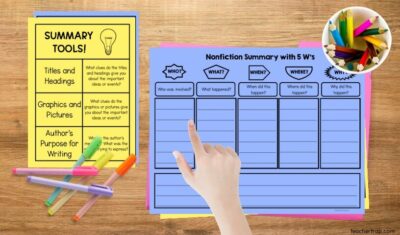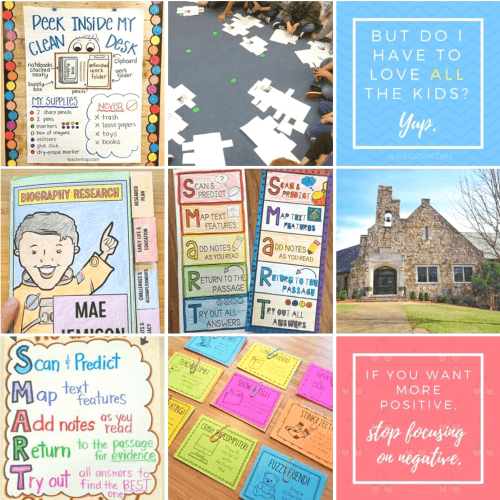Team drama is the worst. Teachers work so hard already, and to do that hard work without the trust and support of an awesome team is a shame. And a pain. Hopefully, these five steps will help you avoid or end any teacher drama in your life.

Step 1: Lighten Up
Easier said than done, I know. But here’s what happens. We work hard, we feel the pressure of mandates and schedules and deadlines and testing, and we begin to lose our sense of humor. I only say that happens because it has happened to me, on multiple occasions.
The easiest way to help change the tone of a team meeting or discussion is to simply lighten up a bit. I’m not saying that you need to have cheesy jokes prepared or start with a goofy team-building game. I’m just saying that if you relax and breathe and smile, others tend to follow your lead. We all want what is best for children. We all want respect and appreciation. But sometimes we get so serious about specifics that we lose sight of the end goal.
How do you do this? Pay attention to how you FEEL. As soon as you start to feel on edge, defensive, disrespected, unappreciated, misunderstood, anxious, etc., let that be a trigger, reminding you to breathe and smile and lighten up.
You can ask yourself questions like, “What will happen if I don’t get my way in this situation?” or “Does this decision need to be made right now?” or “I wonder if Full House is on Netflix yet?” (Distraction works, too.) Force yourself to step back from the situation for a moment.
Since this isn’t always enough, you might need to add in some Step 2…
Step 2: Love the Flaws
This is probably the most powerful way to create a supportive and collaborative environment, and I’ll be the first to say that I’m lacking in this area. I learned this strategy from an awesome teammate who was the master of accepting and appreciating others’ quirks and I saw how it quickly it changed the team dynamics. She didn’t do it on purpose, it was just her personality, but for others (like me) it’s something I have to do intentionally.
How do you do this? You simply pay attention to the habits and behaviors of others, especially the ones that bug you, and then say to yourself, “Ah, that’s so (insert teammate’s name here)! Isn’t she funny?” And you say this to yourself with a loving heart and protective mindset. You love your teammate for who she is and you think of her as YOURS. Think of your team as a WE, not as just the individuals.
Once you feel yourself accepting and laughing about the frustrating things that other people do, it’s easier then to point those things out in a way that won’t be met with anger or defensiveness.
Example: Your teammate Cruella is always late to team meetings and it’s driving you crazy! You can’t stand the way she disrespects the team by coming in late. You’ve had it with her. Now, you could get angry and tell her off. You could lay down the law and put her in her place. You could even go to admin and tattle on her. BUT, none of those options are going to lead to a positive working relationship later and ALL of those options are going to add stress to your life. So instead, you breathe and smile and say to yourself, “Ah, that’s so Cruella. She’s always running late, silly woman!” You shift your thinking and remember that she is a good person and a hard-working teacher and is probably doing her best. Now you want to help her; protect her from herself. When she walks in late and flustered, you pat her on the back and smile. “We’ve got to figure out how to get you here on time! I need you!” you laugh. She smiles back, a bit more aware of her behavior. Is the problem solved? Probably not. 🙂 But the next time, maybe you make a joke to her about telling her the meeting starts ten minutes before it really does, and now she’s more receptive because she feels like you are on her side.
Still feeling frustrated? Try Step 3…

Step 3: Start With Concern
This is a pretty natural progression from Step 2, but now you are actually bringing up specific issues to the person. One of the best tricks I learned for building team trust is the importance of assuming good intentions. I’ll say it again… ASSUME GOOD INTENTIONS. This is hard, and for me it took a lot of practice until it became natural. But, by assuming good intentions, you can then go to the person with a voice of concern, rather than one of attack or judgement.
How do you do this? First, you practice! Start noticing when you think someone has bad intentions and then switch your thinking. Cruella was a great example. She’s always late, so you might choose to assume that she simply has no respect for anyone else OR you could assume she is struggling with time management and keeping up with everything. Maybe you have a teammate who always talks badly about the parents of students at your school and it frustrates you. You could assume she is ignorant or racist or a snob, OR you could assume that she’s had some very bad experiences with a few parents and is protective of her students.
Once you assume good intentions, you can then go to the person and speak with them about the problem from a caring place, rather than a judgmental one.
Example: During a planning meeting you bring up an idea for a lesson, but another teacher dismisses your idea and snaps at you for sharing such a time-consuming activity. You could have assumed this teacher was a rude know-it-all who doesn’t respect you, but instead you wonder if she might be feeling stressed for some reason. You go to her later and check on her. “Hey (insert mean teacher’s name), I just wanted to check in on you. You seemed a little frustrated in our planning meeting. Is everything okay?” She breaks down and tells you about troubles at home and a problem child in her classroom and having trouble fitting all her lessons in during the day. She apologizes for being so snappy in the meeting and hugs you for listening. Yay, team bonding!
Or she has no idea what you’re talking about and you need Step 4…
Step 4: Team Norms
Do you have team norms in place? If not, do it! It feels silly, I know, but team norms allow all the members of the team to share their needs and make for much easier collaboration when things get tough. Honestly, team norms should probably be STEP 1! Team norms vary but some common ones are things like:
- Begin and end on time
- Speak in a respectful tone
- Be fully present
- Show appreciation
How do you do it? Setting team norms is a pretty painless process IF someone leads it and keeps everyone on track. It can easily become a venting ground and erupt into total warfare if not handled properly. The trick is to explain the process and then make the team stick to it. I like a simple process such as…
- Private Think Time (2 min): Everyone writes down things they want or need to do their best work. What will we expect of each other in order to do our very best work? (Side note: List things in the positive! Rather than “Don’t be late,” you would write “Be on time.”
- Share Ideas (3 min): List everyone’s ideas on chart paper. There is NO DISCUSSION, no debating, just list out all the ideas.
- Private Think Time: (2 min): Pick your top 5 most important ideas from the shared list and add a sticker or star by them. NO DISCUSSION.
- Group Discussion: (5 min-ish) The group then works to combine the ideas into the most important 5 – 7 ideas that everyone can agree on. Don’t go over 7 or 8!!
- Finalize: (3 min-ish) Look at the final list. Is there anything important missing? Can we all agree to hold ourselves accountable for these norms?
Once you’ve got your norms, hang them where you meet and use them! If the team is struggling to work together, you’ll want to review the norms before every meeting. Over time, the group might choose to adjust or change the norms, and that’s okay, too. But now when you need to tell someone to “be on time” or “speak respectfully” it doesn’t have to be an attack. You can simply say, “Let’s remember that we all agreed to ____.”
Norms not enough? Oh, dear. Time for Step 5…
Step 5: Clear and Direct Statements
If you’ve tried all of the above and your teammate is still doing the thing that you can’t take anymore, it’s time for a direct intervention. We’ve all heard of “I Statements” and you’ll need to start using them!
How do you do it? Start by clarifying for yourself what you really need or want. Make sure it’s fair and reasonable. Then craft some clear and direct statements that you can use with your teammate. These must be delivered in a calm, but firm voice, preferably in private and not in the midst of the frustrating situation. Raising your voice or losing your temper will simply make the interaction about you and how you are being rude, mean, bossy, etc. You want the person to focus on what you are saying, not how you are feeling.
Examples:
I realize we don’t see eye-to-eye on the best way to teach reading. I respect your opinions and I expect you to respect and listen to mine, as well.
I understand that you have many friends here at school but I would never speak about you to other teachers and I expect you to do the same for me. If you have a problem with something I’ve done, I need you to come talk to me first.
I understand that you don’t like the way our team has chosen to organize Field Day. I wish you had been able to come to the planning meeting, but since you couldn’t we did our best and we need you to follow what we’ve set up.
When to go to admin…
If you have a good relationship with your principal, you might consider going to them for feedback or advice on the situation, but specifically asking them to keep the matter private. This will allow you to bring the problem to their attention, hopefully gain some ideas for improving the situation, and avoid losing the trust of your team/teammate.
Be careful going to admin with the intention of having them solve the problem. This breaks trust and can cause more damage to your team relationships than improvement. Once admin steps in and handles the situation, the specific problem might go away but bigger ones will emerge! So here’s when I’d say you SHOULD consider going to admin for this type of help:
- When you are truly concerned for the best interests of a child (or children).
- When you are truly concerned about a teammate’s physical or emotional well-being.
- When you recognize that you’ve reached a breaking point and may “snap.”
Having a supportive, collaborative team is amazing! And you CAN have this even when you have unique personalities, disagreements, and different teaching preferences. I hope these tips help you create the supportive environment you need to feel good at work.
For more resources on planning and working with your team, you might like my Lesson Planning Pack. I’ve included detailed instructions for setting team norms, tips for working together effectively, and resources for making planning effective and efficient.
I’d love to hear any other tips for working well with your grade-level team or co-workers! This is a tricky challenge and I know we’ve all dealt with it at some point.














